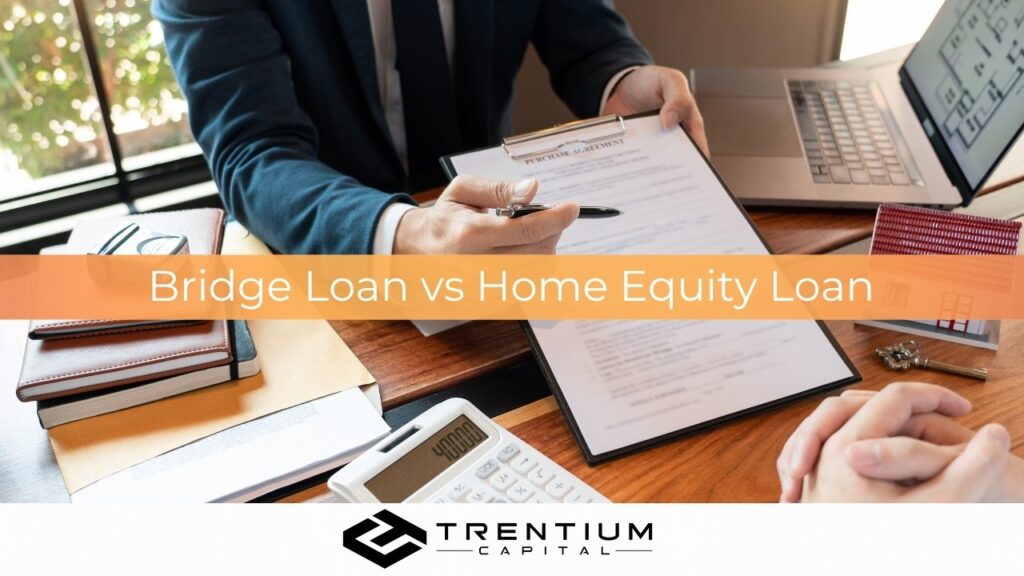Are you stuck between buying your dream home and waiting for your current one to sell?
If your next big financial move depends on liquidity, whether upgrading your home, starting a renovation, or covering temporary expenses, two powerful tools stand out: bridge loans and home equity loans.
But how do you choose between the two? This detailed guide includes the pros, cons, costs, timelines, and ideal use cases for each. By the end, you’ll know exactly which option fits your needs and how Trentium Capital can help you secure it fast.
What Is a Bridge Loan?
A bridge loan is a short-term loan designed to help you “bridge the gap” between two transactions. It is most commonly used when buying a new home before selling your current one.
It’s typically secured by the equity in your current home. It provides fast access to a lump sum, allowing you to make a competitive, non-contingent offer on your next property.
Key Features:
- Short-term: Usually 6–24 months
- Lump-sum disbursement
- Often interest-only with a balloon payment at the end
Bridge loans are especially popular in hot real estate markets where delays can cost you the deal.
What Is a Home Equity Loan or HELOC?
A home equity loan or Home Equity Line of Credit lets you borrow against the equity you’ve built in your current home. These longer-term loans provide a lump sum (HEL) or flexible draw amounts (HELOC).
While not explicitly designed to bridge real estate transactions, these loans can be an alternative when you need funds for renovations, tuition, debt consolidation, or even a new home deposit.
Home Equity Loan vs. HELOC:
- HEL: Fixed interest, lump sum, predictable repayment
- HELOC: Variable interest, draw as needed, pay only what you use
Bridge Loan: Pros and Cons
Advantages
- Fast Funding: Ideal when you need to act quickly in a competitive market
- No Home Sale Contingency: Make offers without waiting to sell your old house
- Flexible Payments: Some allow interest-only payments until the old property sells
Disadvantages
- Higher Interest Rates: Often 10–12%, much higher than traditional loans
- Short Term: Balloon payments can become risky if your house doesn’t sell on time
- Higher Fees: Application, appraisal, origination, and legal costs may apply
Home Equity Loan: Pros and Cons
Advantages
- Lower Interest Rates: Usually between 6–8% for fixed loans, lower than bridge loans
- Longer Repayment Terms: Spreads out your payments over 5 to 30 years
- Flexibility: Great for renovations, medical bills, or investing in business
Disadvantages
- Slower Process: Not ideal for urgent transactions like home purchases
- Qualification Requirements: Credit score and debt-to-income ratios matter
- Variable Rates (HELOC): Monthly payments can increase over time
Which Loan Costs More?
Generally, bridge loans cost more due to their convenience and short-term structure. You pay higher interest and fees in exchange for speed and flexibility. Home equity loans, while slower, offer a lower overall cost if you can wait.
A quick rule of thumb:
- Need cash in weeks? Go with a bridge loan.
- Can you wait a month or more? A home equity loan may be smarter.
Use Cases: When to Choose What
Choose a Bridge Loan When:
- You’re buying a new home before selling your current one
- The market is hot, and non-contingent offers win
- You need fast access to significant capital
Choose a Home Equity Loan or HELOC When:
- You want to renovate or consolidate debt
- You’re not in a rush and want better interest rates
- You prefer a fixed repayment schedule or a revolving credit line
Real Risks to Consider
Both options come with collateral risk; your home is on the line if you default. Bridge loans carry the added risk of your home not selling within the loan term, exposing you to balloon payments.
HELOCs carry interest rate risk, where a fluctuating rate may suddenly raise your monthly payments.
Always consider the worst-case scenario. A financial advisor or Trentium Capital’s in-house team can help model both outcomes.
Bridge Loan vs. Home Equity Loan: Summary Table
| Feature | Bridge Loan | Home Equity Loan / HELOC |
|---|---|---|
| Use Case | Buy before selling | Renovation, debt, and expenses |
| Speed | Very fast (1–2 weeks) | Moderate (2–4 weeks) |
| Interest Rate | High (10–12%) | Lower (6–8% HEL, 7–9% HELOC) |
| Disbursement | Lump sum | Lump sum or revolving |
| Repayment Term | 6–24 months | 5–30 years |
| Collateral | Current home | Home equity |
| Risk Level | Higher (balloon risk) | Moderate (interest rate risk) |
Final Thoughts: Which Loan Is Best for You?
Your financial needs and timeline will dictate which loan is best. If you’re in a tight spot and need fast access to capital before selling your current property, a bridge loan offers the speed and flexibility you need. If you’re seeking lower-cost financing with long-term stability, a home equity loan or HELOC may be your better bet.
No matter your situation, Trentium Capital can help you make the right decision with expert guidance and tailored solutions.



